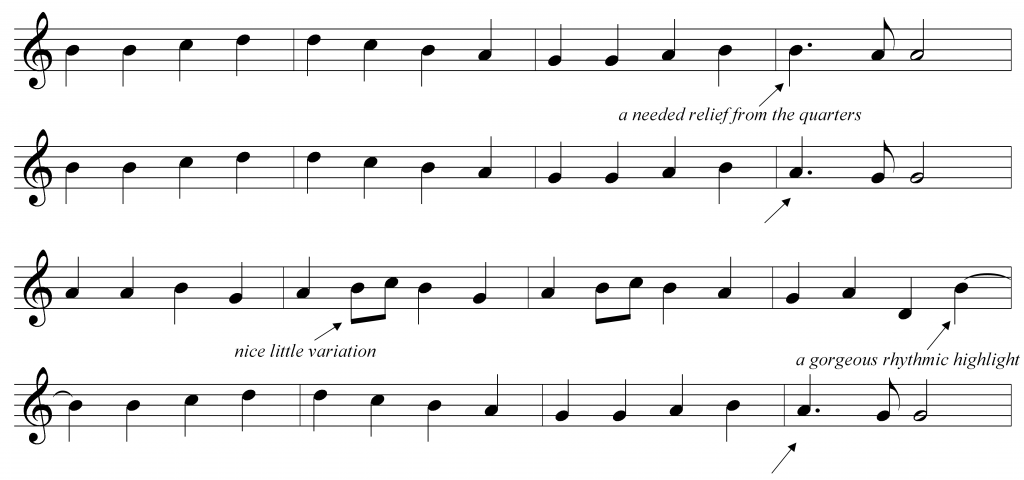Composing Good Rhythm
I moved Composition Corner to Wednesday of this week so that you could have more time to see the Dollars & Sense “Got (enough) Money?” post. This week’s topic in Composition Corner is composing good rhythm. One of the problems mentioned in Problems with Melody is that sometimes students melodies are just plain boring. Of course this can be for a variety of reasons including: rhythmic or melodic problems, lack of motivic development, problems in form, and more. But today, I just to touch on the issue of rhythm in melody and how to compose good rhythm.
3. A Good Melody Contains Rhythmic Interest
This may seem like an obvious statement, but it is amazing what a big difference a little edit in rhythm can make in a melody. Let’s study that famous motive of Beethoven’s Ninth Symphony:
You can easily see where the rhythmic interest lies: The lovely dotted quarter note in m. 4, 8, and 16 as well as the sublime syncopation in m. 12 which almost always gets deleted in method books much to my dismay (albeit, an understanding dismay).
It pains me to see so many method books take out the part of this motive that makes it work rhythmically. Anyone can see that making this melody all quarter notes destroys the rhythmic vitality and interest that Beethoven created. That said, as a composer of early level music, I completely understand the need to do this at a certain place in a method book, though I encourage my students to play it the correct way. In the end, my students don’t seem to mind the all quarter note version since they are playing a piece that is familiar, but I don’t think it’s a bad thing to allow them to play it how they know it-with at least the dotted quarters!
So here is a short list of some ideas for composing good rhythm that create melodic interest:
- Use a variety of rhythms, remembering that like a motive that needs to be repeated, important rhythms need to be repeated as well.
- Place your most important notes on unexpected beats, like “&’s” or beats 2 and 4 in quadruple meter. Making them happen on beats 1 and 3 is extremely predictable and quite boring.
- Try tying a note across the bar line to create rhythmic interest. Throwing the listener who is expecting a downbeat this surprise is quite effective.
- Consider how your listener would expect to hear the rhythm of your melody and compose it in a slightly different way.
The idea here is to connect with the listener by giving them some, but not all of what they expect. A melody crafted with only unexpected rhythms will not connect, but a melody with a few surprises can be effective in creating interest.
Try your hand at suggesting some rhythmic changes that will give this student’s melody just a bit more vitality:
Do you have questions about composing good rhythm? Let me know!



What about adding a tie to the E’s between measures 2 & 3 and syncopating the final B by playing it just a beat earlier?
Love these sharing moments from my fav contemp composer. I’m teaching your “Twister” to my 5-year old little Chinese boy, and he’s going to play it for the Spring recital. Question: Do you want the first part played detached, as in portato, or more legato? I opted for a more connected touch, which he has no trouble executing. What do you think?
Awwww…that’s sweet of you Joanne! I’m honored one of your students is playing Twister. I’d tell him to play it more connected because playing it detached will take too long between each note and it will be hard to play the piece quickly. Tell him that if you play it more connected, then that staccato/accented note in m. 7 will really POP! I tell my students that in the first 6 measures, you are in the middle of the tornado as it swirls around you. Then…WHAM! a mailbox flies by you in m.7! Then it swirls again and BAM! a bike flies over your head in m. 15! Those crazy objects will be more of a surprise if the other part is legato. Maybe that will help!